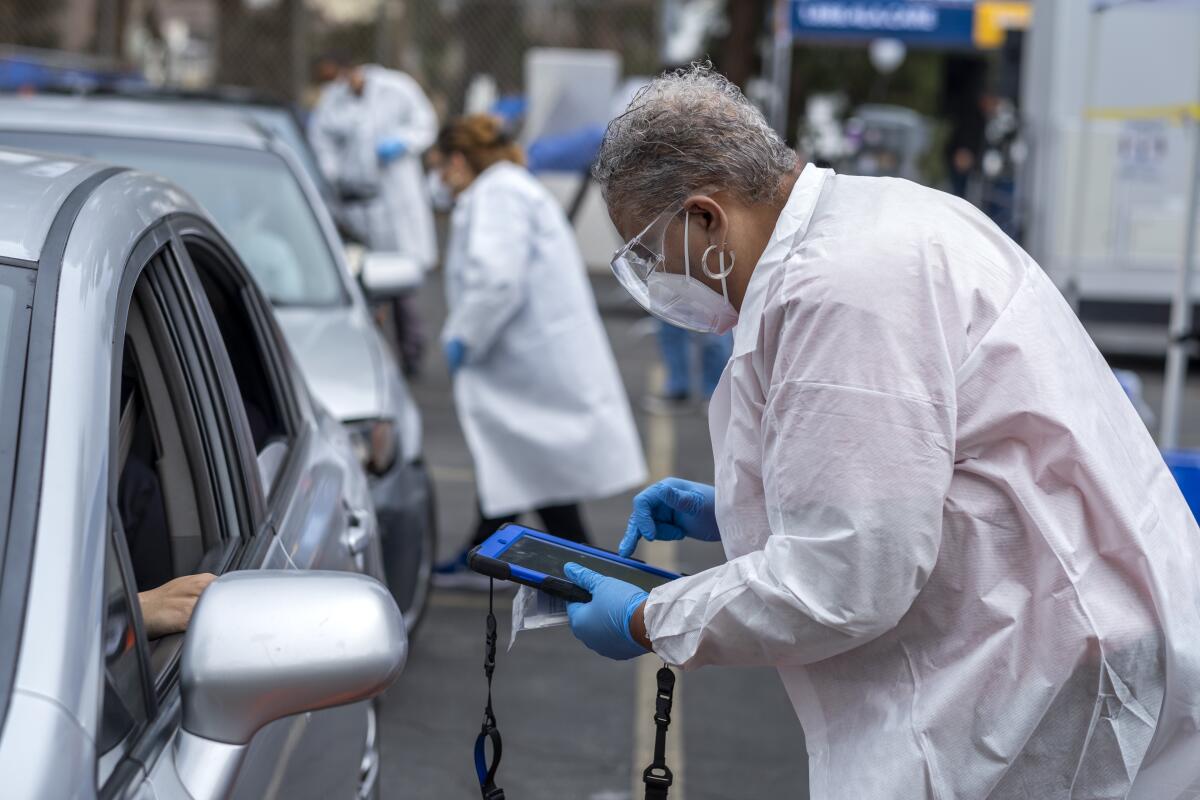The new Omicron subvariant XE is getting attention. How concerned should we be?

- Share via
Even as the highly contagious Omicron subvariant BA.2 is increasingly dominating California and the U.S., an even more potentially contagious subvariant, XE, has attracted the attention of global scientists.
Early estimates as noted by the World Health Organization say XE may be 10% more transmissible than BA.2, but it’s too soon to say whether XE will become the next prolific Omicron subvariant that will become another household name. The British government has also noted that data showing XE’s growth rate advantage over BA.2 have not remained consistent, so more data will be needed to assess XE’s likely future trajectory.
XE was first detected in Britain on Jan. 19, the WHO said. And more than 700 cases of XE have been reported in Britain, with more than 600 of them in England, according to British authorities.
There have not been significant numbers of the XE subvariant in countries outside of Britain, Los Angeles County Public Health Director Barbara Ferrer said Tuesday. To date, there have been only three cases of XE reported in the U.S., and none in California, she said.
The preliminary data available so far suggest XE “is going to be easier to catch,” said UC San Francisco infectious diseases expert Dr. Peter Chin-Hong in an interview, although people who are vaccinated and boosted should have a relatively lower risk of suffering hospitalization and death, as is the case with other Omicron subvariants.
“But if XE becomes more prominent in this country, it does add a little bit of fire for people to get boosted overall. And it adds a little fire maybe for the oldest people in our population to maybe get their second booster,” Chin-Hong said.
There are a few telltale differences between spring allergy symptoms and a COVID-19 infection. But if you’re fully vaccinated, the line can get blurry.
XE likely developed from someone who was co-infected with BA.2 and the earlier Omicron subvariant, BA.1, Chin-Hong said. BA.2 is more contagious than BA.1, and BA.1 was more contagious than the variant that swept the globe last summer, Delta.
So XE is essentially “a child of BA.1 and BA.2 that came together and had a recombinant event. So it arose in one person, and it just spread more easily,” Chin-Hong said. XE likely represents about 1% of new cases in Britain, he said.
“It’s coming at a time that’s a little bit concerning,” Chin-Hong said. “And that time is when jurisdictions and countries are decreasing efforts to track variants and person-power to do sequencing [to identify the variants of new cases], potentially, because you have less resources because it’s quote-unquote ‘not an emergency anymore.’”
That means identifying the latest subvariant or variant might take longer to identify than before, Chin-Hong said.
It’s also possible XE could fizzle out, such as the so-called “Deltacron” subvariants — mishmashes of the Delta and Omicron variants — that gained attention last month but faded from the public view.
The “Deltacron” subvariants are known as XD and XF, Chin-Hong said.
At a briefing to UC San Francisco colleagues last week, infectious diseases expert and epidemiologist Dr. George Rutherford said XD had elements of its genetic material from Delta and Omicron’s BA.1 subvariant; and XF is mostly BA.1 but has some elements of Delta.
An increase in coronavirus cases at schools is occurring in part because of the lifting of indoor mask requirements, L.A. County health officer says.
This mishmash of subvariants is not unexpected, Rutherford said, and viruses go through such recombination all the time. As of last week, British authorities were still “sort of ho-hum about it,” Rutherford said, and more data still need to come out to really determine whether it’s more transmissible than BA.2.
Ferrer agreed that more data need to emerge to really know what to expect with XE. “There is still too little data to draw conclusions about growth advantage or other properties of this variant,” Ferrer said.
“But just be aware that there are these recombinant lineages that are starting to show up,” Rutherford said.
Scientists say the increasing prolificness of new variants is expected when more people are getting infected with the coronavirus. The more infections there are, the more likely are the chances new strains can develop.
Strains that combine aspects of more than one strain are yet another reason to stay vigilant about COVID-19, said Orange County health officer Dr. Regina Chinsio-Kwong.
“We have all been humbled by COVID over the last two years,” Chinsio-Kwong said. “COVID can continue to change … it can decide to escape our immune defenses, even if we’re vaccinated, or it can be more transmissible.”
“The best thing we can do is continue to keep our guard up and be vigilant,” Chinsio-Kwong said.
Creative pandemic-era solutions, including Zoom puppet classes, mobile marionette shows, even wedding planning helped the Bob Baker Marionette Theater thrive.
More to Read
Sign up for Essential California
The most important California stories and recommendations in your inbox every morning.
You may occasionally receive promotional content from the Los Angeles Times.














